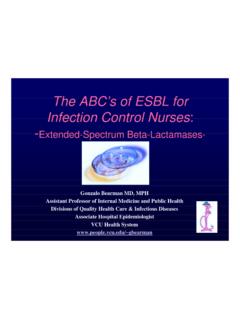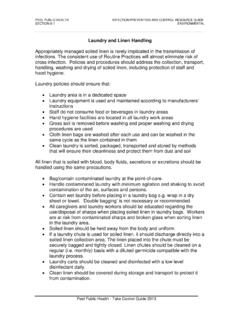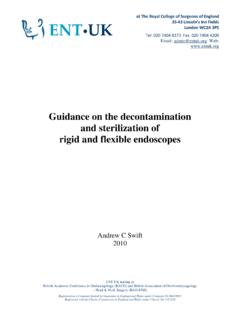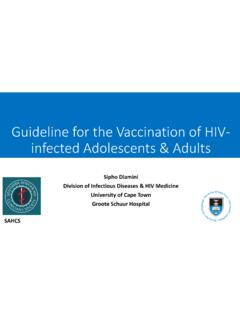Transcription of Checklist for Periodic Evaluation of TB Infection Control ...
1 World Health Organization. 2015 Checklist for Periodic Evaluation of TB Infection Control in Health-Care Facilities PURPOSE OF THE Checklist Nosocomial transmission of TB to people living with HIV, attending care, as well as to health-care workers can be minimized through rigorous implementation of TB Infection Control (TBIC) measures as detailed in the 2009 WHO Policy on TB Infection Control in Health-Care Facilities, Congregate Settings and Households. TB Infection Control requires and complements implementation of core activities in TB Control , HIV Control and health systems strengthening. It should be part of national Infection prevention and Control policies because it complements such policies, in particular, those that target airborne infections . Education and involvement of individuals and their families and communities affected by or at risk of TB is also vital for facilitating a compassionate response based on sound ethics that respects human rights and is free from stigmatization and discrimination.
2 Periodic monitoring and Evaluation is crucial for National AIDS, Infection Prevention and Control (IPC) and TB Programme Managers, general health services and other relevant stakeholders to ensure that national policies and protocols, following WHO global policy on TB Infection Control , are adopted and that all health facilities have appropriate TBIC procedures in place. This is particularly the case in facilities providing any type of care, including TB diagnosis and care, for people living with HIV. Countries may undertake a national assessment of WHO TB Infection Control policy adoption, adaptation, and implementation, and thereafter on an annual basis to measure progress over time. Facility-level assessment of TB Infection Control should be incorporated into routine supervisory activities. Standardised assessment tools facilitate efforts to track progress in TBIC implementation and the attached Checklist could serve as the tool for such an assessment.
3 The Checklist is based on and structured around WHO s 2009 Policy on TB Infection Control which recommends implementation of a basic package of interventions which identify key domains for facility-level controls and congregate settings, namely: (1) Managerial, (2) Administrative, (3) Environmental and (4) Personal protective equipment. It is also aligned with the 2014 WHO s Infection Prevention and Control (IPC) guidelines that also address respiratory infections . The Checklist focuses on primary and secondary health-care facilities. Its use for large hospitals will require modification, as specific risks (such as invasive procedures, autopsies, and specific isolation precautions with mechanical ventilation) may necessitate a more careful and tailored assessment. TB transmission in laboratory settings is a significant concern, but is not addressed in this Checklist .
4 Further guidance can be found in the 2012 WHO s Tuberculosis Laboratory Biosafety Manual. Monitoring progress against global and national indicators on TB Infection Control Included within the Checklist are five key standards in red font for reporting against the two global and national TB/HIV indicators for TBIC as detailed in A guide to monitoring and Evaluation for collaborative TB/HIV activities, 2015 revision, countries namely: 1. Risk of TB among health-care workers relative to the general population, adjusted for age and sex; and 2. Proportion of health-care facilities providing services for people living with HIV that have TB Infection Control practices. The five key standards reflect the demonstrable minimum measures that are consistent with international guidelines and included in A guide to monitoring and Evaluation for collaborative TB/HIV activities, 2015 revision.
5 Achievement of these basic standards demonstrates the implementation of TB Infection Control measures and if any of these standards are not fully met then the facility should not qualify as having TB Infection Control practices as per indicator 2 above. GUIDANCE ON USE OF THE Checklist Proper assessment of TBIC requires knowledge of key interventions and strategies. It is thus critical that evaluators receive standard training in IPC prior to performing any assessment. Ideally, evaluators should have a background in TB, Infection prevention and Control , and the health-care system as a whole. Existing IPC staff may be used for assessment of health-care facilities (other than the ones where they are working) as a means of cross-training and capacity building. As a preliminary step, evaluators should ascertain whom to interview and which areas to assess. Key areas of risk include settings where patients with undiagnosed TB, including MDR-TB, congregate (such as waiting areas, radiology departments, laboratory waiting areas, pharmacies) or where TB patients not yet on treatment are located (such as patient wards).
6 Facilities providing any type of care for people living with HIV, as well as those caring for other immunosuppressive conditions ( diabetic clinics, transplant units) should be prioritized, as such patients are at higher risk of TB disease if exposed and infected. Required background data can be obtained from programme staff (IPC, TB, HIV) and local Ministry of Health staff. These data should be used to organize a schedule of supervision visits. Part 1: Managerial Assessment Evaluators should employ a blame-free interview style and collect or photograph documentation (such as TBIC plans and documents) where available. Generally, facility staff who are responsible for or most knowledgeable about TBIC should be interviewed. Standards #1-6 are self-explanatory, and evaluators should see documentation ( of an Infection Control plan or a confidential occupational health record) before answering yes.
7 All facilities should have a means of recording TB incidence among health facility staff and trends need to be monitored. In order to be able to report against the global indicator Risk of TB among health-care workers relative to the general population, adjusted for age and sex , the denominator (total number of staff) needs also to be reported, along with age and sex. Part 2: Administrative Assessment Standards #7-#11 primarily require observation in addition to asking staff about practices. All components of each question must be present or implemented for the answer to be yes . For standards #12-#16 evaluators should review a random sample of records (at least 10 files which must be selected randomly) to assess promptness in identification of presumed TB patients, TB investigation and treatment initiation, method of TB diagnosis and HIV testing. As extrapulmonary TB is seldom infectious and diagnostic Evaluation can be lengthy, the focus of the sampling for standards #13 and #14 should be on pulmonary TB.
8 Patient files from within the previous year and preferably within the previous 6 months (to assess recent practices) should be selected. Part 3: Environmental Assessment Responses to the standards on environmental assessment primarily rely on observation, so it is essential that evaluators are trained on how to assess these questions. Note that this Checklist focuses primarily on health facilities which rely on natural ventilation. While building renovation may be required to address inadequate environmental controls, a full assessment goes beyond the scope of this simple Checklist . Thus, evaluators should focus on whether simple measures are being taken to reduce risk. Where environmental measures are not satisfactory (despite implementation of simple measures), this should be noted in the recommended actions section and should be flagged for higher level review.
9 In settings where windows are closed or not present, (such as health facilities in cold climates), this Checklist should be modified to include an assessment of mechanical ventilation and ultraviolent germicidal irradiation. Part 4: Personal Protective Equipment Assessment For standards #22 and #23, evaluators should ensure that appropriate particulate respirators (Certified N-95 or FFP2 [or higher]) are available for health-care workers, that a system exists to properly fit test respirators, and that such respirators are being used where indicated. Providing Feedback The findings of the assessment should be communicated to health facility staff and other key stakeholders. Programmes may wish to develop a simple standardized feedback form that can be left immediately following the assessment at the site so that recommendations can be addressed and followed up. Findings can be compiled at the subnational or national level by using a dashboard and/or by developing a simple scoring system to identify common areas that are in need of improvement and prompt follow-up.
10 Checklist FOR Periodic Evaluation OF TB Infection Control IN HEALTH-CARE FACILITIES Health Facility: Region/County/District/Municipality: Type of health facility: ( Dispensary, PHC unit, ART centre, HIV testing and counselling centre) Person completing form and cell number: Date: PART 1: MANAGERIAL Standards (red font indicates standards needed to be met for measuring global and national indicators) Yes/ No Means of verification Recommended Actions 1. There is a written facility-specific Infection Control plan (that includes TB Infection Control (TBIC) Facility Infection Control plan 2. There is a budget allocated for TB Infection Control activities. Budget and expenditure records 3. There is a designated person (and committee in larger facilities) responsible for implementing TBIC practices in the facility. Job description and interview 4. Designated TBIC focal person has received documented TBIC training or refresher training within the past 2 years.)


















